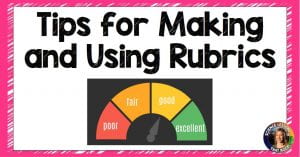Scoring rubrics are explicit schemes for classifying products or behaviors into categories that vary along a continuum. They can be used to classify virtually any product or behavior, such as essays, research reports, portfolios, works of art, recitals, oral presentations, performances, and group activities. Judgments can be self-assessments by students; or judgments can be made by others, such as you as the professor, other students, fieldwork supervisors, and external reviewers. Rubrics can be used to provide formative feedback to students, to grade students, and/or to assess programs. Many LMS platforms have rubrics built in. This is one I use in Canvas:
With rubrics, complex products or behaviors can be examined efficiently. Developing a rubric can help you to precisely define your expectations. When using rubrics for grading, grades generally are criterion-referenced, rather than norm-referenced (based on how well criteria are satisfied, rather than how students perform relative to their peers). Rubrics help you ask, “Did the student meet the criteria for level 5 of the scoring rubric?” rather than “How well did this student do compared to other students?” This is more compatible with cooperative and collaborative learning environments than competitive grading schemes.
California State University, Fresno’s Institutional Research, Assessment and Planning provided the following suggestions on developing your own scoring rubric:
- Identify what you are assessing, e.g., critical thinking.
- Identify the characteristics of what you are assessing, e.g., appropriate use of evidence, recognition of logical fallacies.
- Describe the best work you could expect using these characteristics. This describes the top category.
- Describe the worst acceptable product using these characteristics. This describes the lowest acceptable category.
- Describe an unacceptable product. This describes the lowest category.
- Develop descriptions of intermediate-level products and assign them to intermediate categories. You might decide to develop a scale that runs from 1 to 5 (unacceptable, marginal, competent, very competent, outstanding), 1 to 3 (novice, competent, exemplary), or any other set that is meaningful.
- Ask colleagues who were not involved in the rubric’s development to apply it to some products or behaviors and revise as needed to eliminate ambiguities.
Suggestions for Using Scoring Rubrics for Grading in Online Classes
CSU Fresno also suggested the following, which we have adapted for online classes:
- Include the grading rubric with an assignment posting so students will know your expectations and how they’ll be graded. This should help students master your learning objectives by guiding their work in appropriate directions.
- Use a rubric for grading student work, including essay questions on exams, and return the rubric with the grading on it. Each row in the rubric could have a different array of possible points, reflecting its relative importance for determining the overall grade. Points (or point ranges) possible for each cell in the rubric could be printed on the rubric, and a column for points for each row and comments section(s) could be added.
- Develop a rubric with your students for an assignment or group project (wikis are great for this development exercise). Students can then monitor themselves and their peers using agreed-upon criteria that they helped develop. (Many faculty find that students will create higher standards for themselves than faculty would impose on them.)
- Have students apply your rubric to some sample products (e.g., lab reports) before they create their own. Faculty report that students are quite accurate when doing this, and this process should help them evaluate their own products as they develop them.
- Have students electronically exchange paper drafts and give peer feedback using the rubric, then give students a few days before the final drafts are turned in to you. (You might also require that they turn in the draft and scored rubric with their final paper.)
- Have students self-assess their products using the grading rubric and hand in the self-assessment with the product; then faculty and students can compare self- and faculty-generated evaluations.
There are numerous rubrics already developed and available on the web, which you can customize for your class. One good source for K12 is Rubistar, which contains both a free tool for building rubrics and a database of rubrics developed by other teachers. Another source is RubricMaker. For higher education, check out UW-Stout’s website.

